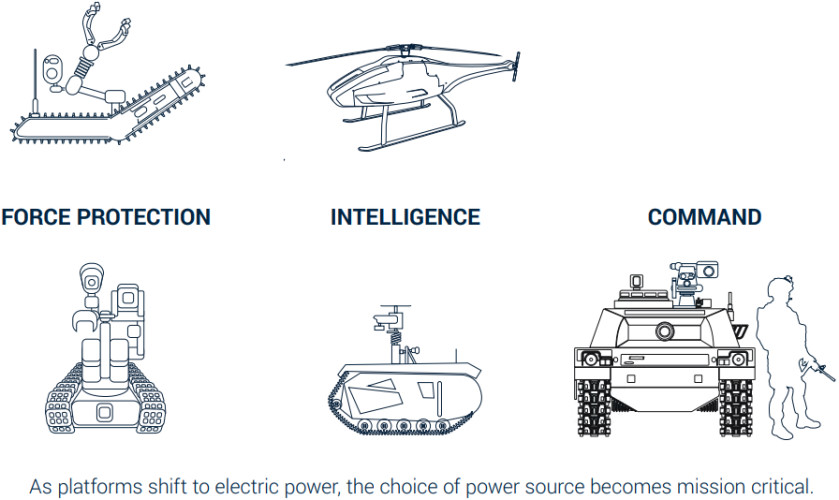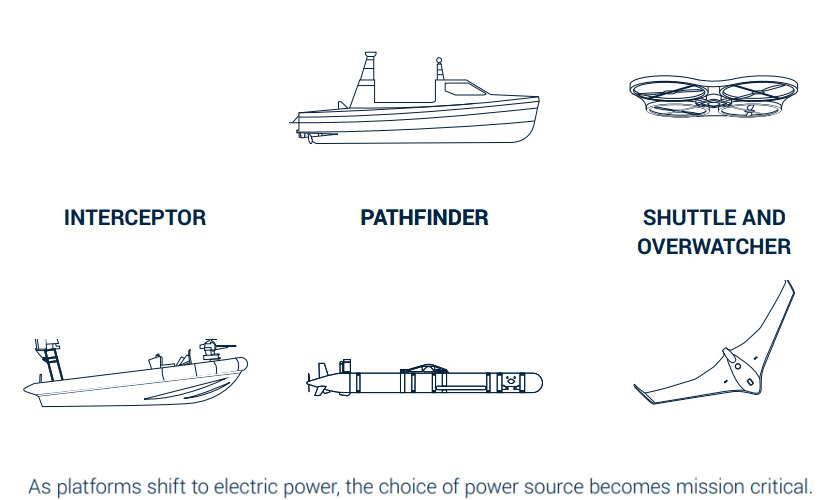Hybrid Platforms: Bringing electrified efficiency to Land, Sea and Air
01/12/2021
Across all domains and platforms, energy innovation is needed now as new technologies demand ever more power, legacy solutions result in wasted resources and avoidable vulnerabilities, and the push towards Net Zero gains momentum.
The next generation of sea, land and air systems have many power needs in common. The best power sources will enable longer mission endurance, high peak power and reduced carbon footprint, without compromising space, weight or safety constraints Achieved with corresponding progress in modular open architectures and logistics innovation, forces will secure an increased operational edge in what is a continuous race for advantage.
From more electric aircraft to electric drive systems on the land and sea, there are significant operational advantages to electrifying the battlespace.
Small and single use
For small assets, such as small unmanned air and underwater systems (UAV, UUV), ocean data gathering solutions and unattended sensors, extended duration, longer range and minimal costs are key, with potential in some cases to move to disposable systems. Informed selection is necessary to choose the right power source that will deliver the necessary performance and have minimal environmental impact if left behind. Often devoted to powering a single piece of equipment. It is critical that consideration is given to cross platform power.
Long endurance
Extending the range and load bearing capabilities of medium assets such as mid and larger size UUVs, organic (to the host platform) unmanned surface vehicles (USVs), platoon robotic vehicles and an increasing number of UAVs that are larger than 20kg, demands high capacity power sources. Whilst some of these will continue to exploit traditional combustion engine power sources, most UAVs and all but the very largest UUVs will rely on batteries or fuel cells with requirements that push beyond current solutions, notably lithium ion.
The drive to keep these systems deployed and to hold off replenishment or recharging, potentially also avoiding disclosing the location of the host or command node will place a premium on endurance. Being able to loiter, stand watch or execute a slow patrol or search covertly for extended durations may also be an integral part of many vehicles’ operating pattern. In many instances this will not be well suited to current solutions, perhaps increasing the importance of advanced power solutions for surface and ground vehicles. Novel, improved batteries and fuel cells will all contribute.
Delivering peak power and endurance
As larger vehicles are developed with more complex missions, so the power needs reflect those of traditional crewed systems, often requiring both endurance and high peak power to deliver their mission. Accelerating from a cold start requires immediate access to bursts of energy. High pulse power solutions will be a critical dependency for effective deployment of novel technologies, such as directed energy systems. Logistics footprints, very high reliability/MTBF, the challenges of replenishment and the need for stealth, minimising signatures must all also be considered. Systems such as the US Sea Hunter and Robotic Combat Vehicle (Medium) and their emerging mission profiles and operating concepts, are clear examples.
Multiple solutions are in development with potential to revolutionise these applications and require clear standards and form factors to provoke industry development towards ground breaking products. Modular power that can be stacked to meet the needs of different platforms will provide a core building block. Hybrid electric drive systems for land platforms can create new design options that improve mobility, durability and adaptability across the frontline. Their success relies on novel energy storage solutions in the short and long term.
Optimising vehicles for Land, Sea and Air
Electrical energy sources can also be more adaptable for use on ships and aircraft, even becoming a structural element of these vehicles that are embedded during construction. Structural and conformable batteries offer the opportunity to develop bespoke power sources that fit the needs of on-board space in air, sea and land assets. Furthermore, some batteries and supercapacitors can be produced in a flexible form factor, which could be integrated into the platform as a structural element, saving internal space and allowing for alternative weight distribution and giving the best on-board position.
Multiplying the benefit
Platform electrification combined with deployable smart microgrids and renewable energy generation will have a substantial impact on the armed forces’ reliance on a fossil fuel supply chain and have the added advantage that the vehicle battery could be used to supply power back to a microgrid. Now holistic interoperable solutions are needed to multiply the benefits of energy innovation and to create infrastructure, logistics and capability lifecycle changes that lend themselves to adopting and integrating the best technologies as they become available. Smart hubs and interoperability will be essential to success. The result will support the next great leap in deployed force capability across Land, Sea and Air.
The operational advantages extend to cost efficiency, since replacing fossil fuel refills with power recharges from power generated sustainably on or near the battlespace could reduce supply chains. Renewable energy sources can be used to service low-level power requirements – such as wave-powered propulsion for autonomous survey platforms and solar cells to power self-sufficient smart sensors. Although this is a use case that requires low levels of energy, the operational impact of cutting back on transportation to the front line is far from small.
Wireless power transfer, either using current (near field) inductive technology and in the future beamed from a directed energy system, can enable recharging with minimal disruption to operations and potentially reduces the risk to deployed personnel.
Remote charging stations deployed in the field and underwater will increase operational flexibility and reduce the visibility and vulnerability of core locations. Electrical platforms can move between these remote chargers to expand their operational range away from base.
Critical power
These advantages provide compelling proof points to support research into more electrified vehicle platforms deployed across Land, Sea and Air. The benefits of applying electrification across all deployed operations are clear to see, with the potential reductions in cost to supply a clear return. Research into this field continues to be a key area for QinetiQ and one where there are sure to be rich discoveries to support deployed forces and gain efficiency for Land, Sea and Air.
As platforms shift increasingly to electric power, the size, weight, and lifecycle of fuel cells and batteries become critical mission enablers and extenders.

